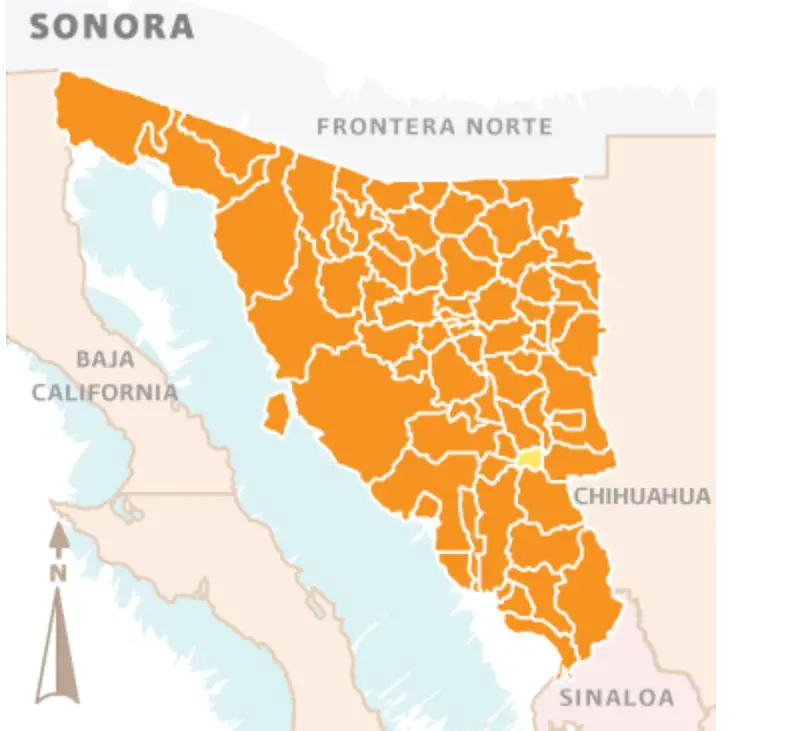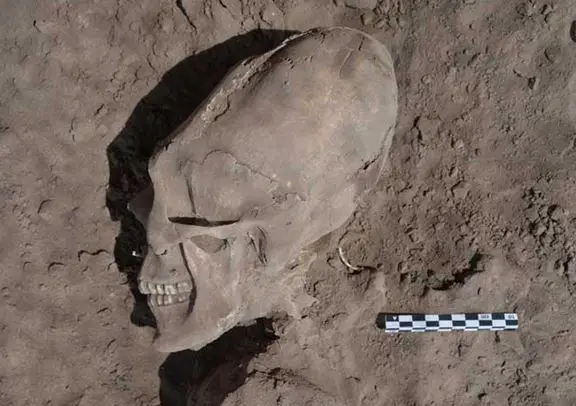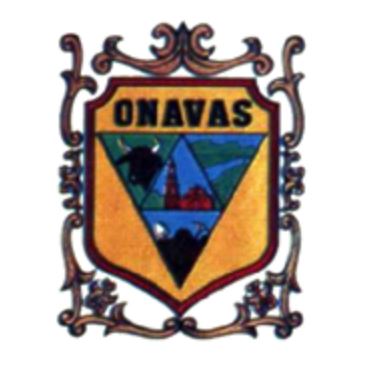Podcast: Play in new window | Download
Subscribe: Apple Podcasts | RSS
 On the road from Hermosillo to Chihuahua, just across the Río Yaqui and right outside the small town of Ónavas in the southeastern part of the Mexican state of Sonora several men were digging a ditch. One of the workers found a skeleton with a strangely formed skull along with ornaments and other artifacts that were most unusual. Before proceeding with the construction of this irrigation canal, a member of the work crew contacted the authorities. The year was 1999. The local office of the National Institute of Anthropology and History, known by the Spanish abbreviation INAH, came to the location and shut down the irrigation project. The locals backfilled the ditch and abandoned their plans for bringing much-needed water to local farms. Some of the details of what appeared to be an old burial ground were kept secret for fear of looters and curiosity seekers disturbing the site. INAH kept a tight lid on the location until over a decade later when formal excavation began at the site, which was informally known as the Ónavas Cemetery.
On the road from Hermosillo to Chihuahua, just across the Río Yaqui and right outside the small town of Ónavas in the southeastern part of the Mexican state of Sonora several men were digging a ditch. One of the workers found a skeleton with a strangely formed skull along with ornaments and other artifacts that were most unusual. Before proceeding with the construction of this irrigation canal, a member of the work crew contacted the authorities. The year was 1999. The local office of the National Institute of Anthropology and History, known by the Spanish abbreviation INAH, came to the location and shut down the irrigation project. The locals backfilled the ditch and abandoned their plans for bringing much-needed water to local farms. Some of the details of what appeared to be an old burial ground were kept secret for fear of looters and curiosity seekers disturbing the site. INAH kept a tight lid on the location until over a decade later when formal excavation began at the site, which was informally known as the Ónavas Cemetery.
The modern town of Ónavas dates back almost 400 years, to the year 1622. The Jesuits established the mission of San Ignacio de Loyola there which still stand in the center of Ónavas. An old statue of San Ignacio greets visitors to the town to this day. The two priests in charge of the small mission were Diego Vandersipe from Ghent, Belgium and a Spanish Jesuit named Blas de Paredes who hailed from Toledo. The area around the mission was called “Ona Boas” by the locals. In the Mayo and Yaqui languages, this translates to “Bitter Water” and the place was so named for the slightly salty taste to the groundwater in the area. The native name “Ona Boas” became corrupted to Ónavas within a few decades of the arrival of the Spanish. The town never grew to be any notable size and has always been populated by just a few hundred people, even through to the 21st Century. 400 years ago, the Yaqui had small farming villages along the river that bears their name and the area around Ónavas produced corn, squash and beans. The villages for the most part peacefully coexisted in a loose confederation or associated status. Local Yaqui lore tells of a powerful, wealthy, and warlike people called the Tomichi who once inhabited the area around Ónavas before the Yaquis lived in the river valley. Archaeologists believe the Tomichi were a Pima people, closely related to, if not the direct ancestors of, the Tohono O’odham. The present-day homeland of the Tohono O’odham straddles the US-Mexico border where Arizona and Sonora meet almost 500 miles north of the town of Ónavas. Some are quick to point out that this is all just a guess, and the real identity of the mysterious Tomichi people of Yaqui legend has nothing to do with the ancient Pimas or the modern-day Tohono O’odham tribe.
 Formal digging at the site outside Ónavas – called El Cementerio – began in late 2012, over 13 years after the burials were discovered by the workers digging the irrigation canal. Under the watchful eye of the Mexican National Institute of Anthropology and History, an excavation led by Cristina García Moreno from Arizona State University uncovered 25 sets of remains during the first archaeological season. 17 of these individuals were minors – between 5 months and 16 years old – and 8 were adults. 13 of the skeletons had bizarre looking, severely deformed elongated skulls. 5 of the skeletons had what looked like upon first inspection, dental mutilations, with their teeth sharpened to points. Only one of the skeletons was that of a female. When photos of these strange skeletons made it to the internet, many interesting theories popped up as to the possible origins of the people, or beings, buried at Ónavas. The internet – being what it is – had armchair researchers proposing many different things. Were these skeletons alien in origin and was Ónavas the site of an ancient interstellar base? Were these people refugees from South America where skull elongation was common? Did the skeletons belong to a different type of human, an offshoot of homo sapiens? Were these people alien-human hybrids? Did they perhaps have a mix of DNA from regular humans combined with that of the nefarious Greys, the big-headed, almond-eyed creatures from Zeta Reticuli? Serious investigation of the Ónavas site ended in April of 2013 thus answering some of these questions but at the same time leaving many others unanswered.
Formal digging at the site outside Ónavas – called El Cementerio – began in late 2012, over 13 years after the burials were discovered by the workers digging the irrigation canal. Under the watchful eye of the Mexican National Institute of Anthropology and History, an excavation led by Cristina García Moreno from Arizona State University uncovered 25 sets of remains during the first archaeological season. 17 of these individuals were minors – between 5 months and 16 years old – and 8 were adults. 13 of the skeletons had bizarre looking, severely deformed elongated skulls. 5 of the skeletons had what looked like upon first inspection, dental mutilations, with their teeth sharpened to points. Only one of the skeletons was that of a female. When photos of these strange skeletons made it to the internet, many interesting theories popped up as to the possible origins of the people, or beings, buried at Ónavas. The internet – being what it is – had armchair researchers proposing many different things. Were these skeletons alien in origin and was Ónavas the site of an ancient interstellar base? Were these people refugees from South America where skull elongation was common? Did the skeletons belong to a different type of human, an offshoot of homo sapiens? Were these people alien-human hybrids? Did they perhaps have a mix of DNA from regular humans combined with that of the nefarious Greys, the big-headed, almond-eyed creatures from Zeta Reticuli? Serious investigation of the Ónavas site ended in April of 2013 thus answering some of these questions but at the same time leaving many others unanswered.
Bone samples were taken to a lab in Hermosillo for analysis while archaeologists pieced together what life might have been like for the mysterious people found at the Ónavas site. To researchers directly working on the project, Ónavas was most likely the place of an elite burial. The artifacts found with the skeletons, and perhaps the deformation of the skeletons themselves, indicated high status. Alongside the strange skeletons, archaeologists found shells from the Sea of Cortez, pottery from central Mexico and turquoise from what is now the American Southwest. While some remains were laid to rest fully adorned in jewelry that would have only belonged to members of the upper classes, other remains had absolutely nothing associated with them. When Carbon 14 results came back indicating that the mysterious people lived sometime between 900 and 1200 AD, researchers with ASU and INAH theorized that these were ancient Pima people who were part of a wealthy trading class that must have controlled important trade routes where they crossed the Yaqui River. The elongated skulls and deformed teeth were extremely puzzling, though, because these practices were never found this far north in Mexico. Ónavas is not considered to be located in Mesoamerica, culturally or geographically. It’s too far north. It’s closer to the US-Mexico border than it is to the Maya area, for example. The drastically deformed skulls and pointy teeth were anomalies for the region.
 Intentional cranial deformation has been reported in the archaeological record from as far back as the Upper Paleolithic and has occurred across many geographical areas and cultures. In Mexico, the Maya elites practiced the reshaping of the head as a mark of beauty and high social status. Many Maya rulers are depicted on monuments and in art as having slanted foreheads peaking to almost a cone. It’s almost a characteristic and unmistakable Maya “look.” The reshaping process starts at almost the time of birth with splints placed on the front and back of the head wrapped in bandages until the head attains the desired shape. The boarding and wrapping can last several years, but usually doesn’t go beyond early childhood. The researchers at the Ónavas site noted that the children with the cranial deformations in the burials had no indications of disease or accident for cause of death. Perhaps they died, the scholars believe, because of cranial deformation procedures that had gone wrong. This would make sense in this context. If this sort of practice was unheard of for this time and place, perhaps the elites of ancient Ónavas were trying to copy their more advanced neighbors far to the south, and not being so experienced in this custom, did not know how to carry out the remolding of the heads properly so as not to cause serious injury. The result was disastrous for these children who were obviously part of the upper class. No other elongated skulls have ever been found even close to this area, which indicates that this practice was a passing fad. Perhaps some traders or even elite visitors from central or southern Mexico traveled to the once-flourishing Ónavas trading area and that sparked the locals’ attempts to copy this particular custom. The same could be said about the dental mutilations. These skulls were not of aliens with sharp teeth but were rather local rulers who wanted to be more like the kings and queens of the more complex and wealthier civilizations many hundreds of miles away.
Intentional cranial deformation has been reported in the archaeological record from as far back as the Upper Paleolithic and has occurred across many geographical areas and cultures. In Mexico, the Maya elites practiced the reshaping of the head as a mark of beauty and high social status. Many Maya rulers are depicted on monuments and in art as having slanted foreheads peaking to almost a cone. It’s almost a characteristic and unmistakable Maya “look.” The reshaping process starts at almost the time of birth with splints placed on the front and back of the head wrapped in bandages until the head attains the desired shape. The boarding and wrapping can last several years, but usually doesn’t go beyond early childhood. The researchers at the Ónavas site noted that the children with the cranial deformations in the burials had no indications of disease or accident for cause of death. Perhaps they died, the scholars believe, because of cranial deformation procedures that had gone wrong. This would make sense in this context. If this sort of practice was unheard of for this time and place, perhaps the elites of ancient Ónavas were trying to copy their more advanced neighbors far to the south, and not being so experienced in this custom, did not know how to carry out the remolding of the heads properly so as not to cause serious injury. The result was disastrous for these children who were obviously part of the upper class. No other elongated skulls have ever been found even close to this area, which indicates that this practice was a passing fad. Perhaps some traders or even elite visitors from central or southern Mexico traveled to the once-flourishing Ónavas trading area and that sparked the locals’ attempts to copy this particular custom. The same could be said about the dental mutilations. These skulls were not of aliens with sharp teeth but were rather local rulers who wanted to be more like the kings and queens of the more complex and wealthier civilizations many hundreds of miles away.
As news of the Ónavas site spread, the chief archaeologist at the site, Cristina García Moreno, found herself in the middle of the many theories swirling around regarding ancient astronauts and alien-human hybrids. García Moreno made this statement to the press in December of 2012:
“Cranial deformation has been used by different societies in the world as a ritual practice, or for distinction of status within a group or to distinguish between social groups. The reason why these individuals at El Cementerio deformed their skulls is still unknown. The most common comment I’ve read from people that see the pictures of cranial deformation has been that they think that those people were ‘aliens.’ I could say that some say that as a joke, but the interesting thing is that some do think so. Obviously, we are talking about human beings, not of aliens.”
 When the research lab at Hermosillo confirmed that the DNA of the skeletons was 100% human, the door was not closed on an otherworldly connection to this strange site. Those who do not wish to give up on a link to aliens have claimed that the people buried at the Ónavas site were copying extraterrestrial visitors rather than elites from other parts of ancient Mexico. The classic shape of the head seems unmistakably not of this earth. Could they have been copying people or beings who had traveled a farther distance than the Maya?
When the research lab at Hermosillo confirmed that the DNA of the skeletons was 100% human, the door was not closed on an otherworldly connection to this strange site. Those who do not wish to give up on a link to aliens have claimed that the people buried at the Ónavas site were copying extraterrestrial visitors rather than elites from other parts of ancient Mexico. The classic shape of the head seems unmistakably not of this earth. Could they have been copying people or beings who had traveled a farther distance than the Maya?
There are no massive monuments or other indications of a yet-unknown highly advanced civilization found in the area. Unless the early Jesuit fathers carted off anything of serious archaeological interest centuries ago, the wealthy local trading elite theory seems to fit this situation. The people found at Ónavas probably became incredibly rich off of long-distance trade that traversed their area and were not part of any larger complex civilization, per se. Perhaps these skeletons belong to the legendary Tomichi people who the Yaquis claimed were there before they came to the Yaqui River valley. The fact that less than 30 individuals were discovered at Ónavas with very little else found in the region’s archaeological record makes this unusual pre-Hispanic cemetery even more mysterious.
REFERENCES
Choi, Charles Q. “Alien-Like Skulls Found in Mexico,” in Live Science. 20 Dec. 2012.
Enciclipedia de los Municipios y Delegaciones de Mexico (website in Spanish)
Travel by Mexico Blog
